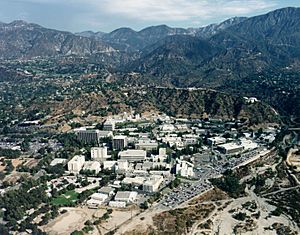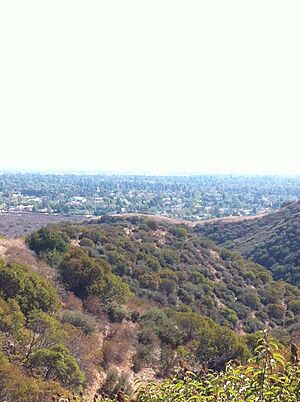Foothills of the San Gabriel Valley facts for kids

The Foothills of the San Gabriel Valley are the foothills and hills found in the San Gabriel Valley. This area is in eastern Los Angeles County, California. These foothills include the lower slopes of the San Gabriel Mountains. They also include smaller, separate hill ranges. This region is part of the larger Greater Los Angeles area. These landforms are part of the Transverse Ranges System. This is a group of mountain ranges in Southern California and Baja California.
Contents
Where Are the Foothills?
These hill ranges generally run alongside the San Andreas Fault to the north. This fault is a very long crack in the Earth's crust. The foothills also follow the Interstate 210 freeway. This is why the freeway is often called the "Foothill Freeway." This freeway stretches for about 86 miles. It goes from Sylmar in the west. It then passes through the foothills and valleys like the San Gabriel and Pomona Valleys. It ends in Redlands in the east.
Main Foothills and Hill Ranges
Here are some of the important foothills and hills in the San Gabriel Valley:
- Foothills of the San Gabriel Mountains – these are along the southern side.
- Puente Hills
- San Jose Hills
- San Rafael Hills
- South Hills
- Verdugo Mountains
Nature and Green Spaces
The foothills are home to many greenbelts. These are natural areas that help keep cities from spreading too much. They also have Open Space Preserves and Regional parks. These are places where people can enjoy nature. The undeveloped hill areas are part of California's Mediterranean climate California chaparral and woodlands ecoregion. An ecoregion is a large area with similar ecosystems. Here, you can find chaparral and Oak savannas. These are types of habitats.
Plants and Wildfires
The plants here include chaparral, grassland, and oak woodland communities. These plants have grown to live with wildfires. Some native plants actually need natural fires to grow back. Chaparral is a very common plant community in California. It has tough, hard-leaved shrubs. These plants are shaped by dry summers and mild, wet winters. Fires naturally happen every 30 to 150 years in chaparral areas. If fires happen too often, the habitat can be lost. It might even turn into non-native grasslands.
Higher up in the mountains, you find montane forests. These forests have trees like pine and fir. They grow at elevations from 3,000 to 8,500 feet. Lower parts of these forests have big-cone Douglas fir and Coulter pine. You can also see canyon live oak and California bay trees. Higher up, you might find lodgepole, limber, ponderosa, and Jeffrey pines. White fir and incense cedar also grow there. Some trees at lower elevations are sensitive to fire. They are often found in rocky areas where fire spreads less easily.
Fire Safety in the Foothills
The foothills have a very high risk of wildfires. Many cities in this area are in "Very High Fire Hazard Severity Zones." This means they are at great risk for dangerous fires. Wildfires are a natural part of the environment here.
How Climate Change Affects Fires
Our planet's climate is changing quickly. In California, less rain will fall as snow. This means less water can be stored in the snowpack. So, dry summers could have even less water available. Summer temperatures will also get hotter in many places. Fire "seasons" may become even longer.
CAL FIRE (the California Department of Forestry and Fire Protection) changes its readiness levels for fire season. When the weather gets warm and dry, and plants are very dry, CAL FIRE gets ready. They increase emergency response staff. Fire stations are open 24 hours a day. More firefighters are hired. When the weather cools down, and rain or snow arrives, the fire threat goes down. Then, CAL FIRE reduces its readiness. They might release some firefighters and close some stations.


